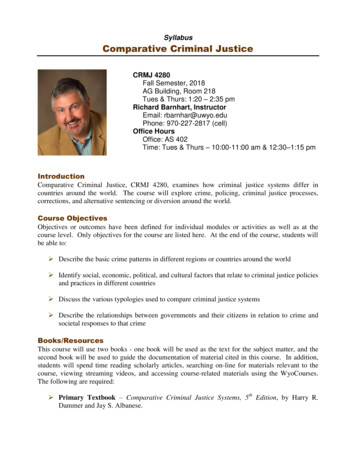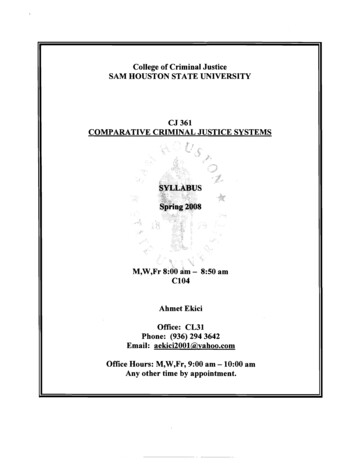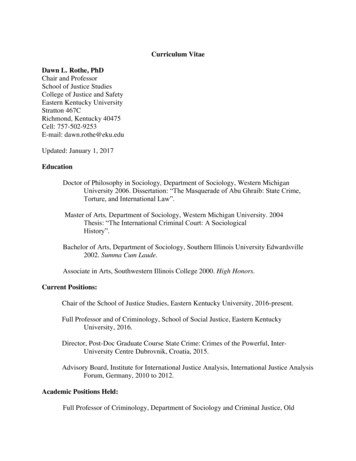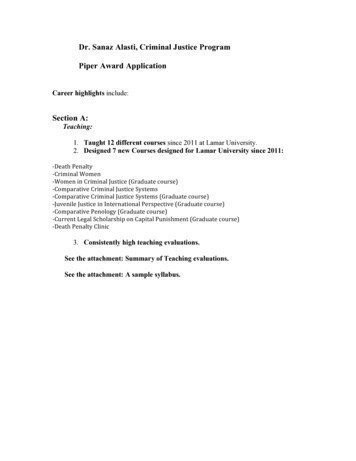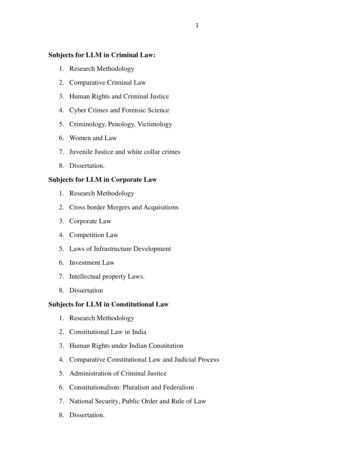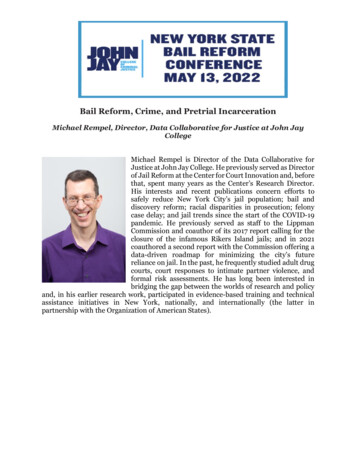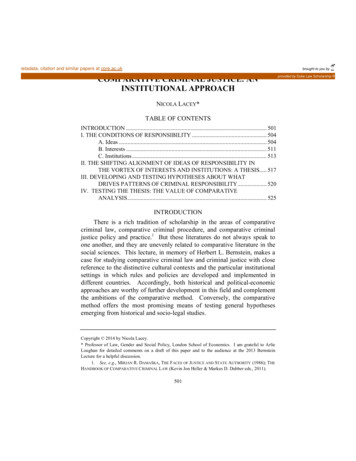
Transcription
LACEY MACRO(DO NOT DELETE)6/26/2014 10:15 PMView metadata, citation and similar papers at core.ac.ukbrought to you byCOMPARATIVE CRIMINAL JUSTICE: ANINSTITUTIONAL APPROACHNICOLA LACEY*TABLE OF CONTENTSINTRODUCTION . 501I. THE CONDITIONS OF RESPONSIBILITY . 504A. Ideas . 504B. Interests . 511C. Institutions . 513II. THE SHIFTING ALIGNMENT OF IDEAS OF RESPONSIBILITY INTHE VORTEX OF INTERESTS AND INSTITUTIONS: A THESIS. 517III. DEVELOPING AND TESTING HYPOTHESES ABOUT WHATDRIVES PATTERNS OF CRIMINAL RESPONSIBILITY . 520IV. TESTING THE THESIS: THE VALUE OF COMPARATIVEANALYSIS . 525INTRODUCTIONThere is a rich tradition of scholarship in the areas of comparativecriminal law, comparative criminal procedure, and comparative criminaljustice policy and practice.1 But these literatures do not always speak toone another, and they are unevenly related to comparative literature in thesocial sciences. This lecture, in memory of Herbert L. Bernstein, makes acase for studying comparative criminal law and criminal justice with closereference to the distinctive cultural contexts and the particular institutionalsettings in which rules and policies are developed and implemented indifferent countries. Accordingly, both historical and political-economicapproaches are worthy of further development in this field and complementthe ambitions of the comparative method. Conversely, the comparativemethod offers the most promising means of testing general hypothesesemerging from historical and socio-legal studies.Copyright 2014 by Nicola Lacey.* Professor of Law, Gender and Social Policy, London School of Economics. I am grateful to ArlieLoughan for detailed comments on a draft of this paper and to the audience at the 2013 BernsteinLecture for a helpful discussion.1. See, e.g., MIRJAN R. DAMAŠKA, THE FACES OF JUSTICE AND STATE AUTHORITY (1986); THEHANDBOOK OF COMPARATIVE CRIMINAL LAW (Kevin Jon Heller & Markus D. Dubber eds., 2011).501COREprovided by Duke Law Scholarship Repository
LACEY MACRO (DO NOT DELETE)502DUKE JOURNAL OF COMPARATIVE & INTERNATIONAL LAW6/26/2014 10:15 PM[Vol 24:501In a lecture devoted to comparative law, the area of criminal justice is,today, a highly apposite focus. Notable shifts in many parts of the worldsince the 1970s in the boundaries of criminalization and in the scope ofpunishment and changes in the procedural protections surrounding theapplication of nation states’ criminalizing and penal powers2 speak to somevery basic legal ideals: notably to the quality of the rule of law and to howcompletely the values embodied in its tenets about the role of law inmediating the relationship between individuals, groups, and the state arerealized. Increasingly, developments are also observable at a transnationallevel, as supranational political and legal orders move into the business ofcriminalizing and sanctioning states, corporations, and individuals.But can comparative scholarship systematically shed light on criminallaw and criminalization in late modern societies? Or does national andregional variation and variation across time and institutional levels rule outa more synthetic or general project? As conceptions of crime and ideals oflegality are necessarily inflected by their specific origins in continentalEuropean and Anglo-Saxon legal and political traditions, respectively, dothey invite a more particularistic treatment?In building a case for an institutional approach to comparative legalscholarship, I focus on the issue of criminal responsibility. My aim is toprovide an overview of the idea of responsibility in criminal law and itsdevelopment over time in English criminal law and to sketch a hypothesisabout what drives that development. Additionally, by applying a sociolegal methodology to the analysis of one concept in a particular systemover time, I aim to provide a case study of methodology in legalscholarship more generally. I argue that this method is capable ofextension to a comparative context and also that the thesis developed in myoverview of English criminal law could most effectively be tested bysubjecting it to critical comparative examination. In developing thismethod, I attempt to escape the narrowness of doctrinal scholarship byaligning myself with a long line of traditions that resist the idea of legalscholarship as autonomous and that insist on the importance of studyinglaw and legal practices in a social, historical, and institutional context: theProcess School in the United States, Law and Society and socio-legalscholarship, and critical legal scholarship. Equally, however, I avoidseveral unhelpful oppositions that have sometimes characterized critical or2. See DAVID GARLAND, THE CULTURE OF CONTROL: CRIME AND SOCIAL ORDER INCONTEMPORARY SOCIETY (2001); NICOLA LACEY, THE PRISONERS’ DILEMMA: POLITICAL ECONOMYAND PUNISHMENT IN CONTEMPORARY DEMOCRACIES (2008); Nicola Lacey, The Resurgence ofCharacter: Responsibility in the Context of Criminalization, in PHILOSOPHICAL FOUNDATIONS OFCRIMINAL LAW 151 (R.A. Duff & Stuart P. Green eds., 2011).
LACEY MACRO(DO NOT DELETE)2014]COMPARATIVE CRIMINAL LAW: AN INSTITUTIONAL APPROACH6/26/2014 10:15 PM503socio-legal, cross-disciplinary studies of law by acknowledging a concernwith agency and structure, focusing on cultural and material forces asimportant factors in the explanation of how law evolves and works,exploring law’s autonomy while also attending to its heteronomy, andrecognizing the importance of intellectual and material history forexplaining the evolution of law.My argument sets out from two very simple assumptions. First, Iassume that responsibility is best thought of as a set of ideas that play twomajor roles in the development of modern criminal law: legitimation andcoordination. In other words, conceptions and elaborated doctrines settingout the conditions of responsibility serve to legitimate criminal law as asystem of state power, this in turn being a condition for criminal law’spower to coordinate social behavior, a task that it accomplishes in part byspecifying the sorts of information or knowledge that have to be proven inthe trial process precedent to conviction. Second, I assume that three mainaspects of its environment shape responsibility: ideas, interests, andinstitutions. These three contextual aspects affect its conceptual contoursand its role or what is required of it.I understand ideas as prevailing social narratives, knowledges andunderstandings of the normative contours and significance ofresponsibility. As such, ideas form the dominant frame for accounts ofcriminal responsibility in the philosophy of criminal law and indeed instandard doctrinal histories. They are, however, inadequate in themselvesto explicate the trajectory and significance of responsibility because theyare in turn shaped by, and have influence on, interests.I understand interests as prevailing structures of power and theirdynamics (often legitimized by ideas). Interests in this sense form thedominant explanatory frame in economic, political, and some legal history.As such, they focus on the key influence on criminal law andcriminalization of patterns of social status and the distribution of wealth,resources, social, and political voice and influence. Yet interests too areboth filtered through and shape institutions.I understand institutions as the political system, economic institutions,courts, trial process, and judicial system more generally (the legalprofession, the judiciary, the media, and other relevant professions—e.g.,the police, prosecutors, and criminal justice officials of various kinds); thecivil service; the penal system; and, increasingly in many countries,corporate interests. Many, though not all, of these institutions loom largein criminal justice and political histories and in some (but by no means all)legal histories. They both constrain and enable developments emergingfrom ideas and interests. Yet their independent importance has been poorly
LACEY MACRO (DO NOT DELETE)504DUKE JOURNAL OF COMPARATIVE & INTERNATIONAL LAW6/26/2014 10:15 PM[Vol 24:501incorporated into most criminal law (and indeed other legal) scholarship.This is equally true, moreover, of much comparative scholarship, which hasalso tended to focus largely on legal doctrines—a puzzling fact, given thatthe different features of legal procedure that have attracted so muchcomparative attention are realized through systematically differentinstitutional frameworks, which are themselves embedded in broaderinstitutional features of the relevant social and political systems.I will therefore argue that an account premised on the coevolution ofthese three spheres in the production of doctrines and practices of criminalresponsibility attribution is needed, one that assumes a mutuallyconstitutive relationship between these three broad spheres rather thanprivileging any one of them. In other words, the underlying notion of aresponsible subject is shaped by an interlocking set of conditions thatchange over time and place in tandem with factors such as the humansituation, prevailing ideas, institutions, and the distribution of power. Thisimplies that legal scholarship has to be historical and comparative inoutlook and located within a social, political, and economic framework if itis to build a broad interpretation of the developing relationship betweenconcepts such as responsibility and the factors that explain their shiftinginfluence over time.I. THE CONDITIONS OF RESPONSIBILITYA. IdeasA number of more or less discrete ideational frameworks for theunderstanding of criminal responsibility have influenced English criminallaw over the last 250 years. Each of them is shaped by assumptions aboutthe nature of human (or corporate or indeed animal) agency, and each hasimplications for the relationship between that agent and the state or otherbody that wields criminalizing power, in particular for the accountability oranswerability of that agent and the conditions thereof. Two principalquestions arise: the question of legitimation, or what is seen as justifyingthe calling to account of individuals or other bodies in the name of thecriminal process (or the state), and the question of coordination, or whatinformation must be marshaled to invoke that legitimated practice ofcalling to account, including matters such as rules of evidence andprocedure and the substantive doctrines of criminal law.Criminal responsibility has developed through four principalideational frames: capacity, character, harmful outcome, and risk.3 The3. Nicola Lacey, Space, Time and Function: Intersecting Principles of Responsibility Across the
LACEY MACRO(DO NOT DELETE)2014]COMPARATIVE CRIMINAL LAW: AN INSTITUTIONAL APPROACH6/26/2014 10:15 PM505underlying justification and legitimating narratives of these four frames arephilosophically distinct, and the frames draw on different political andsocial knowledge and come in varied versions that hold greater or lesssway at different times. Yet they nonetheless can and do coexist inparticular systems of criminal law at particular times. After tracing the fourideational frames, I will consider the question of how they relate to oneanother in the development of English criminal law. I will do so by tracingthe changing interests, power, and distribution of resources that conditionthese ideational frameworks and the institutional arrangements thatunderpin them: not only criminal justice processes such as policing,prosecution, trial, and proof but also broader social and politicalinstitutions.First, and most obviously, in modern legal discourse we are familiarwith the idea that criminal responsibility is founded in capacity. At theheart of this vision of criminal responsibility sits the notion of an agentendowed with powers of understanding and self-control.4 This notion wasmost fully developed in post-Enlightenment social philosophy but existedin thicker and thinner versions in earlier and later philosophies. It wasdeveloped primarily in relation to human beings but was susceptible toextension to, for example, corporate entities and animals. Under thisnotion of capacity responsibility, respect for agency and individual freedomis central. Capacity theories hence assume either freedom of the will orsome version of compatibilism, under which the idea that human conduct isto some degree determined is not inconsistent with genuine responsibility.Capacity responsibility implies a very stringent set of legitimatingrequirements for state criminalization and punishment. Only whencriminal law is addressed to human beings as choosing subjects capable ofconforming their actions to the criminal law can it be compatible withindividual freedom.Two significantly different legal versions of capacity responsibilityneed to be distinguished. On one hand, there is capacity as choice, whichgenerally appears through subjective mens rea or fault requirements: legalrules guarantee respect for agency by making intention, knowledge, orforesight the paradigm conditions for criminal liability. On the other hand,there is capacity as fair opportunity, which appears in a broader conceptionof mens rea that includes negligence and “objective” recklessness: respectTerrain of Criminal Justice, 1 CRIM. L. & PHIL. 233 (2007).4. See Nicola Lacey, In Search of the Responsible Subject: History, Philosophy and SocialSciences in Criminal Law Theory, 64 MOD. L. REV. 350 (2001); Nicola Lacey, Responsibility andModernity in Criminal Law, 9 J. POL. PHIL. 249 (2001).
LACEY MACRO (DO NOT DELETE)506DUKE JOURNAL OF COMPARATIVE & INTERNATIONAL LAW6/26/2014 10:15 PM[Vol 24:501for agency is satisfied so long as the agent has a fair chance to conform hisor her behavior to the requirements of criminal law. Both versions of thecapacity theory of responsibility also imply a generous panoply of defensesencompassing circumstances under which the normal conditions of choiceor opportunity-taking are disrupted by external circumstances or thebehavior of third parties (or a combination of the two) and by exemptingconditions, such as forms of mental incapacity that deprive the agent ofminimum levels of cognitive and/or volitional power. A paradigm exampleof capacity responsibility would accordingly be the case of someone whointentionally causes grievous bodily harm to another. Excusing conditions,such as duress, or exempting conditions, such as mental incapacity, furtherrefine the compatibility of doctrinal arrangements with the underlyingconception of responsibility.Second, there is the notion of responsibility as founded in character,itself an idea with diverse philosophical origins as different as Aristotelianphilosophy and its intellectual descendant, virtue ethics; Christiandoctrines; and the empiricism of David Hume.5 There are at least threedifferent senses in which assumptions about, or evaluations of, characterhave informed attributions of responsibility in English criminal law. Thereis the most fundamental sense of “character responsibility,” or the idea thatan attribution of criminal responsibility is in some sense a judgment of abad or vicious character and is legitimized by that fact. This sense ofcharacter responsibility itself consists of two distinct components: a moralor quasi-moral judgment and the projection of that moral judgment onto thequality of individual character.Character responsibility in this second sense occupies a rather widespectrum. The more robust senses of character responsibility invite us tocondemn not merely the sin—a judgment that could in itself be stronglyevaluative—but also, and fundamentally, the sinner. At its most extreme,moreover, character responsibility proper exhibits “character essentialism”and “character determinism.” In other words, it proceeds from a view—theological or, increasingly in an era marked by secularization, scientific orquasi-scientific—of human character or identity as fixed, or at least asrelatively stable, and it regards character as determining conduct. At theother end of the spectrum, there is character responsibility as a view ofcriminal conviction grounded in the manifestation of a viciouscharacteristic or character trait or a disposition hostile to the norms ofcriminal law, which might be out of character and which does not5. See NICOLA LACEY, WOMEN, CRIME, AND CHARACTER: FROM MOLL FLANDERS TO TESS OF(2008).THE D’UBERVILLES 12–40
LACEY MACRO(DO NOT DELETE)2014]COMPARATIVE CRIMINAL LAW: AN INSTITUTIONAL APPROACH6/26/2014 10:15 PM507necessarily mark a propensity to express such characteristics. Betweenthese ends of the spectrum, there are intermediate positions in whichcriminal conduct expressing vicious characteristics gives rise to a strongeror weaker presumption of bad character in the sense of propensity. Theimpulse to move from an evaluation of conduct to the sort of evaluation ofcharacter that marks the more extreme versions of character responsibilityhas surfaced at key points in the history of English criminal justice.6 It haslarge implications for the extent to which criminal law exhibits astigmatizing temper and for how much it is seen as addressing free andequal subjects as opposed to managing a threat posed by particularcategories of subject, whether identified in terms of past behavior,neuroscientific or psychological evidence, or otherwise. And the differentversions of character responsibility have, of course, different implicationsin terms of the doctrinal preconditions of guilt (as well as for how it mightbe proven): the mental states and choices that are central to the capacitynotion of responsibility continue to matter as evidence of or proxies forfeatures of character, expressed dispositions, neural conditions, or attitudeshostile to the norms of criminal law. Thus, patterns of attribution foundedin character are concerned with judging the defendant within a distinctiveevidential and temporal frame.Third, criminal law has not infrequently invoked a notion of outcomeresponsibility, attributing responsibility primarily or purely on the basis ofthe defendant having caused an outcome proscribed by the criminal law.Here, the underlying philosophical frame is consequentialist: criminal lawis conceived as a distinctive system of regulation oriented to public harmreduction. Again, outcome responsibility comes in more and less stringentforms. For example, pure causal responsibility, as in a doctrinal system ofabsolute responsibility, founds its legitimating narrative not only in themoral importance of causing harm but also in the idea that the effects wecause in some sense become part of our identity.7 Even if we are lessresponsible in one sense for an accidentally caused harm, such as injuringsomeone after being jostled and losing one’s balance, most of us wouldfind it inappropriate if a person who had inadvertently caused harm in thisway simply shrugged his or her shoulders and said, “That has nothing to dowith me.” In practice, however, most outcome responsibility in criminallaw is less stringent than this, mitigating absolute liability by means of theapplication of general defenses and/or of a specific “due diligence” or “nonegligence” defense. Alternatively, there is outcome responsibility in6. Lacey, supra note 2.7. See TONY HONORÉ, RESPONSIBILITY AND FAULT 14–40 (1999).
LACEY MACRO (DO NOT DELETE)508DUKE JOURNAL OF COMPARATIVE & INTERNATIONAL LAW6/26/2014 10:15 PM[Vol 24:501terms of the special duties that attach to particularly dangerous activities,such as driving cars and engaging in potentially harmful industrialprocesses and other commercial activities.Finally, and overlapping with both outcome responsibility andcharacter responsibility, there is responsibility as founded in risk. Again,responsibility as risk comes in several different versions, with risk beingconceived in either clinical or actuarial terms. The idea of attachingresponsibility to clinical risk or pathology shades into the more extremeversions of character responsibility. Risk-based responsibility also equatesto a more inchoate version of outcome responsibility and might indeed beregarded as a product of the emergence of disciplines such as statistics or ofa range of medical techniques that enable, or purport to enable, theprediction of outcomes.Each of these four overlapping yet distinctive ways of thinking aboutcriminal responsibility have sounded in English criminal law over the last250 years. But they themselves, and the relative influence that they holdwithin the criminal law, have also been shaped by broader cultural ideasthat make up the environment in which ideas of responsibility develop.Among these, the most salient include attitudes towards violence andtowards the proper relationship between the individual and the state; ideasabout democracy and forms of governance; beliefs about human nature,specifically social Darwinism, eugenics, and early criminology, and aboutsex and gender; and the process of secularization and the accompanyingdecline in the significance of religious symbols in legitimatingcriminalization and punishment.Changes in legal ideas aboutresponsibility are the product of a much broader set of ideas about the selfand about relations between the self and society that significantly affectboth the legitimation challenges faced by criminal law and theopportunities for legitimation and coordination that are available.8 Hencethey need to be contextualized within intellectual and social history. Forthe purposes of this lecture, I will focus on just three of these broader ideas:those about the nature of individual agency and the role of environment inshaping subjectivity, the growth of the psychological and social sciencessince the mid-nineteenth century, and the emergence of utilitarian thinking.First, ideas about the nature of individual agency and the role ofenvironment in shaping subjectivity are shifting over time and are at issuein prevailing understandings of responsibility. In his exploration of the“sources of the self,”9 Charles Taylor shows how the key elements of8. See Lacey, supra note 5, at 25–34.9. CHARLES TAYLOR, SOURCES OF THE SELF: THE MAKING OF THE MODERN IDENTITY (1989).
LACEY MACRO(DO NOT DELETE)2014]COMPARATIVE CRIMINAL LAW: AN INSTITUTIONAL APPROACH6/26/2014 10:15 PM509modern individual selfhood—notably, the idea of selfhood as involving asense of inwardness—were assembled over many centuries, with markeddevelopments associated with Augustine, Descartes’ Cogito, and Locke’ssensational psychology.10 Glimpses of a reflexive human self focused onits own interior are visible in Shakespeare’s plays, in Montaigne’s essays,and in innumerable diaries and letters of the early modern period. But,Taylor argues, it continued to develop up to the philosophies of theEnlightenment and indeed beyond.Taylor focused his attentionexclusively on the development of ideas of selfhood within philosophicaltexts, a focus which, as he acknowledged, omitted any assessment of thesocial institutions within which these ideas evolve.More recently, historian Dror Wahrman has investigated theinstitutional context of Taylor’s argument, analyzing the “making of themodern self” through a mesmerizing array of cultural practices, includingbeekeeping manuals, novels, theater, fashion, portraiture, and translationsof the classics.11 Warhman argues that the Enlightenment philosophies ofthe seventeenth century, most notably Locke’s view of the individual as“tabula rasa” (to be shaped by experience) and the decline of faith in anessential human nature located in a divinely ordered universe, gave birth toa new and fluid conception and social practice of identity, whose definingfeature was that identity had to be created and assumed. As a socialconstruct, an individual could be modified through the adoption of differentclothes, different manners, or different associates. In the 1780s, thisexternal, socially constructed notion of selfhood began to be displaced bythe “modern regime of identity,” in which individual personhood isbelieved to inhere in the unique and stable inner self that ultimately foundits most complete expression in Romanticism. While the older ideas ofidentity resonated with the idea that responsibility attribution residesprimarily in the assessment of visible indices of character, the idea that theself resides in an authentic psychological self implied a need to investigatethe interior world of the defendant as a means of assessing responsibility.Only then did an investigation of the psychological interior become10. Taylor’s is not a radically relativist position. In his account, core aspects of selfhood werealready in place in ancient Greek philosophy and have been in a process of development from this coreacross the centuries, hence the recognizability to modern readers of figures like Moll Flanders. Id.11. DROR WAHRMAN, THE MAKING OF THE MODERN SELF: IDENTITY AND CULTURE INEIGHTEENTH-CENTURY ENGLAND (2004). For other important works historicizing selfhood andexploring the conditions under which emerging ideas of selfhood operate and by which they areenabled, see REWRITING THE SELF: HISTORIES FROM THE RENAISSANCE TO THE PRESENT (Roy Portered., 1997); NIKOLAS S. ROSE, GOVERNING THE SOUL: THE SHAPING OF THE PRIVATE SELF (1990);RICHARD SENNETT, THE FALL OF PUBLIC MAN (1977); PATRICIA MEYER SPACKS, IMAGINING A SELF:AUTOBIOGRAPHY AND NOVEL IN EIGHTEENTH-CENTURY ENGLAND (1976).
LACEY MACRO (DO NOT DELETE)510DUKE JOURNAL OF COMPARATIVE & INTERNATIONAL LAW6/26/2014 10:15 PM[Vol 24:501generally important to the legitimation of criminal law.Second, the growth of the psychological and social sciences since themid-nineteenth century has been a key factor in the development of the latemodern idea of criminal responsibility founded in cognitive and volitionalcapacity. The idea that criminal responsibility can be enunciated in termsof states of mind—intention, foresight, belief, and so on—is premised on adualistic vision of a human being that can be traced to Descartes and on theidea that the interior world of human individuals can be the object of socialknowledge and, indeed, of proof in a criminal court. In this context, thedevelopment of what we now call psychology was of general assistance tothe development of the subjective theory of mens rea that is so influentialin English criminal law today.This development pulled in different directions, however, which helpsto explain the slow, uneven, and incomplete development towards asubjective notion of capacity responsibility. For example, the idea that thesubjective mental states of human beings could be the object ofinvestigation in a criminal court promised a “factualization” of criminalresponsibility that would make it less dependent on local knowledge orshared evaluations and hence, crucially, less controversial.12 On the otherhand, it also threatened to undermine the project of developing a discreteand technical, legal conception of criminal responsibility because itappeared to assume a privileged position for medical and psychologicalevidence. The well-documented turf wars between the judiciary and thenascent psychiatric profession throughout the nineteenth century,13 thecontinued place of older discourses of madness as manifest in the sense ofbeing recognizable to lay observers,14 and the persistence of value-ladenmens rea terms such as “maliciously” well into the twentieth century15 areeloquent testimony to the courts’ concern with establishing their ownautonomous professional expertise and to their continuing commitment toand confidence in the idea of legal judgment as evaluative rather thanfactual or scientific. Moreover, the development of the social and human12. See ALAN NORRIE, CRIME, REASON AND HISTORY: A CRITICAL INTRODUCTION TO CRIMINALLAW 15–32 (2d ed. 2001).13. See, e.g., NORRIE, supra note 12; ROGER SMITH, TRIAL BY MEDICINE: INSANITY ANDRESPONSIBILITY IN VICTORIAN TRIALS (1981); Joel Peter Eigen, Lesion of the Will: Medical Resolveand Criminal Responsibility in Victorian Insanity Trials, 33 LAW & SOC’Y REV. 425 (1999).14. See ARLIE LOUGHNAN, MANIFEST MADNESS: MENTAL INCAPACITY IN CRIMINAL LAW(2012).15. See Jeremy Horder, Two Histories and Four Hidden Principles of Mens Rea, 113 LAW Q.REV. 95 (1997) (discussing the historical and continuing importance of the principle of malice inEnglish criminal law); see also Lacey, supra note 4.
LACEY MACRO(DO NOT DELETE)2014]COMPARATIVE CRIMINAL LAW: AN INSTITUTIONAL APPROACH6/26/2014 10:15 PM511sciences,16 most obviously those genetic or social Darwinian argumentsthat appeared to undermine the idea of individual freedom and hence,potentially, that of the capacity-based responsibility for crime, promptedanother interesting accommodation of character and capacity models incriminal policy. It underpinned the frequent attempts from the 1860s on toidentify and subject to special, character-based policies certain groups ofoffenders—habitual inebriates, habitual offenders, the weak-minded, thevagrant, and the juvenile delinquent17—while assuming the existence offreedom and hence capacity responsibility for other offenders.Third, the emergence of utilitarian thinking, in both its pureBenthamite form and in the modified form developed in John Stuart Mill’sfamous essay, On Liberty, had a key influence on conceptions of criminalresponsibility. As has been widely discussed, it became a powerfulimpetus for law reform,18 but it also u
criminal law, comparative criminal procedure, and comparative criminal justice policy and practice.1 But these literatures do not always speak to one another, and they are unevenly related to comparative literature in the social sciences. This lecture, in memory of Herbert L. Bernstein, makes a case for studying comparative criminal law and .



